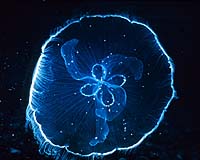| . |  |
. |
Washington DC (SPX) Jun 23, 2009 A team of NOAA-supported scientists from the Louisiana Universities Marine Consortium, Louisiana State University, and the University of Michigan is forecasting that the "dead zone" off the coast of Louisiana and Texas in the Gulf of Mexico this summer could be one of the largest on record. The dead zone is an area in the Gulf of Mexico where seasonal oxygen levels drop too low to support most life in bottom and near-bottom waters. Scientists are predicting the area could measure between 7,450 and 8,456 square miles, or an area roughly the size of New Jersey. However, additional flooding of the Mississippi River since May may result in a larger dead zone. The largest one on record occurred in 2002, measuring 8,484 square miles. Dead zones are caused by nutrient runoff, principally from agricultural activity, which stimulates an overgrowth of algae that sinks, decomposes, and consumes most of the life-giving oxygen supply in the water. The dead zone size was predicted after researchers observed large amounts of nitrogen feeding into the Gulf from the Mississippi and Atchafalaya Rivers. The rivers experienced heavy water flows in April and May that were 11 percent above average. "The high water volume flows coupled with nearly triple the nitrogen concentrations in these rivers over the past 50 years from human activities has led to a dramatic increase in the size of the dead zone," said Gene Turner, Ph.D., a lead forecast modeler from Louisiana State University. This forecast helps coastal managers, policy makers, and the public better understand and combat the sources of the dead zones. For example, the models that generate this forecast have been used to determine nutrient reduction targets required to reduce the size of the dead zone. This hypoxic, or low-to-no oxygen area, is of particular concern because it threatens valuable commercial and recreational Gulf fisheries by destroying critical habitat. "As with weather forecasts, this forecast uses multiple models to predict the range of the expected size of the dead zone. The strong track record of these models reinforces our confidence in the link between excess nutrients from the Mississippi River and the dead zone," said Robert Magnien, Ph.D., director of NOAA's Center for Sponsored Coastal Ocean Research. "This advanced warning is just one example of NOAA's growing ecological forecasting capabilities that allow managers to protect valuable resources and coastal economies in a proactive manner." NOAA has been funding investigations and forecast development for the dead zone in the Gulf of Mexico since 1990 and currently oversees the two national hypoxia programs authorized by the Harmful Algal Bloom and Hypoxia Research and Control Act. Data from the U.S. Geological Survey on river flow and nutrient concentrations this spring was critical information required by the models to produce the forecasts. An announcement of the official size of the 2009 hypoxic zone, which is an annual requirement of the Gulf of Mexico Task Force Action Plan, will follow a NOAA-supported monitoring survey led by the Louisiana Universities Marine Consortium on July 18-26. In addition, NOAA's Southeast Area Monitoring and Assessment Program currently is providing near real-time data on the hypoxic zone during a five-week NOAA Fisheries Service summer fish survey in the northern Gulf of Mexico between June 8 and July 18. The information is available on the NOAA's Gulf of Mexico Hypoxia Watch Web page. The objective of Hypoxia Watch is to develop new near-real-time data and map products using shipboard measurements of bottom-dissolved oxygen and to disseminate them over the Internet. These products form the basis for summertime advisories to fishermen in the North-central Gulf of Mexico, indicating where fish and other living marine resources may not be found due to low or non-existent oxygen levels. NOAA understands and predicts changes in the Earth's environment, from the depths of the ocean to the surface of the sun, and conserves and manages our coastal and marine resources. Share This Article With Planet Earth
Related Links NOAA Water News - Science, Technology and Politics
 Jellyfish Joyride A Threat To The Oceans
Jellyfish Joyride A Threat To The OceansCanberra, Australia (SPX) Jun 18, 2009 New research led by CSIRO Climate Adaptation Flagship and University of Queensland scientist, Dr Anthony Richardson, presents convincing evidence that this 'jellyfish joyride' is associated with over-fishing and excess nutrients from fertilisers and sewage. "Dense jellyfish aggregations can be a natural feature of healthy ocean ecosystems, but a clear picture is now emerging of more severe ... read more |
|
| The content herein, unless otherwise known to be public domain, are Copyright 1995-2009 - SpaceDaily. AFP and UPI Wire Stories are copyright Agence France-Presse and United Press International. ESA Portal Reports are copyright European Space Agency. All NASA sourced material is public domain. Additional copyrights may apply in whole or part to other bona fide parties. Advertising does not imply endorsement,agreement or approval of any opinions, statements or information provided by SpaceDaily on any Web page published or hosted by SpaceDaily. Privacy Statement |